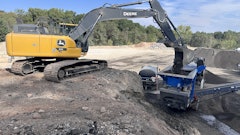
Winter is coming to the Northern Hemisphere. That means reinforced concrete bridges, parking garages, and buildings could be in for a wild ride on the “roller coaster” of freeze-thaw cycling. To minimize damage from these inevitable temperature swings, Cortec recommends taking the simple maintenance step of applying a water repellent at least once every ten years.
Here’s a closer look at why that is important.
Residents of northern climates know what it is like to experience days or weeks of freezing winter temperatures, followed by a sudden thaw that temporarily melts snow and ice before freezing it again. Unfortunately, concrete absorbs moisture, which expands when it freezes, putting stress on the concrete and eventually causing it to crack. This allows more corrosives to enter, exacerbating the problem until corrosion and deterioration set in.
 Cortec Corporation
Cortec Corporation
Benefit of Applying Water Repellents
One simple step toward minimizing the effect of the freeze-thaw cycle is to limit the amount of moisture (and chlorides) entering the porous structure by applying a silane water repellent that still leaves the concrete breathable and does not change its appearance. A good practice to follow is application once every 10 years, starting as early as possible in the life of the structure.
Choose Your Level of Protection
Engineers and contractors can choose from a range of silanes that offer varying degrees of protection, but the fact is that any water repellent is better than nothing. The use of a 40 percent silane water repellent tends to be more budget-friendly, while the use of a 100 percent silane water repellent keeps out more moisture. Combining either of these with a surface applied corrosion inhibitor (SACI) is even better, providing two-in-one protection against the ingress of corrosives and actively fighting against corrosion at the rebar level if any corrosives do find their way into the concrete.
 Cortec Corporation
Cortec Corporation
How to Apply
In order to get the best performance out of silane-based water repellents, it is essential to apply the material properly. Make sure to follow the manufacturer’s application instructions carefully. Generally, the concrete substrate should be sound and fully cured before the application.
Concrete surfaces should be free of contaminants that may plug the pores and obstruct the material’s penetration. Cleaning and surface preparation can be done using steam cleaning, water blasting, scarifying, grinding, or blasting. This can be followed by rinsing and drying for optimal absorption. The material can then be applied using a low-pressure airless sprayer, roller, or brush until the surface is saturated.
The number of coats and coverage rates may vary based on the manufacturer, but it is generally one to two coats at 100-200 ft.2/gal (2.5-5 m2/L). Allow the material to penetrate and cure before opening up the area for traffic or before subsequent topical applications. Avoid overapplication, runoff, or pooling, and make sure proper safety precautions are followed and proper PPE is used as suggested in the material’s safety data sheet.
Reapplication may be needed periodically (e.g., every seven to 12 years) based on exposure levels and service life requirements.
An Extra Layer of Protection
The next time you shiver at the thought of winter snow and cold, be sure to consider giving an extra layer of protection to your reinforced concrete to help it withstand harsh winters better. Whether your concrete is new or old, adding a water repellent is a great way to fortify your concrete structure against the effects of freeze-thaw cycling to promote a longer service life.


















![Lee Boy Facility 2025 17 Use[16]](https://p1-cms-assets.imgix.net/mindful/acbm/workspaces/default/uploads/2025/09/leeboy-facility-2025-17-use16.AbONDzEzbV.jpg?ar=16%3A9&auto=format%2Ccompress&fit=crop&h=135&q=70&w=240)
